Neuroregulation by vasoactive intestinal peptide (VIP) of mucus secretion in ferret trachea: activation of BK(Ca) channels and inhibition of neurotransmitter release
- PMID: 10051131
- PMCID: PMC1565792
- DOI: 10.1038/sj.bjp.0702288
Neuroregulation by vasoactive intestinal peptide (VIP) of mucus secretion in ferret trachea: activation of BK(Ca) channels and inhibition of neurotransmitter release
Abstract
1. The aims of this study were to determine: (1) whether vasoactive intestinal peptide (VIP) regulates cholinergic and 'sensory-efferent' (tachykininergic) 35SO4 labelled mucus output in ferret trachea in vitro, using a VIP antibody, (2) the class of potassium (K+) channel involved in VIP-regulation of cholinergic neural secretion using glibenclamide (an ATP-sensitive K+ (K(ATP)) channel inhibitor), iberiotoxin (a large conductance calcium activated K+ (BK(ca)) channel blocker), and apamin (a small conductance K(ca) (SK(ca)) channel blocker), and (3) the effect of VIP on cholinergic neurotransmission using [3H]-choline overflow as a marker for acetylcholine (ACh) release. 2. Exogenous VIP (1 and 10 microM) alone increased 35SO4 output by up to 53% above baseline, but suppressed (by up to 80% at 1 microM) cholinergic and tachykininergic neural secretion without altering secretion induced by ACh or substance P (1 microM each). Endogenous VIP accounted for the minor increase in non-adrenergic, non-cholinergic (NANC), non-tachykininergic neural secretion, which was compatible with the secretory response of exogenous VIP. 3. Iberiotoxin (3 microM), but not apamin (1 microM) or glibenclamide (0.1 microM), reversed the inhibition by VIP (10 nM) of cholinergic neural secretion. 4. Both endogenous VIP (by use of the VIP antibody; 1:500 dilution) and exogenous VIP (0.1 microM), the latter by 34%, inhibited ACh release from cholinergic nerve terminals and this suppression was completely reversed by iberiotoxin (0.1 microM). 5. We conclude that, in ferret trachea in vitro, endogenous VIP has dual activity whereby its small direct stimulatory action on mucus secretion is secondary to its marked regulation of cholinergic and tachykininergic neurogenic mucus secretion. Regulation is via inhibition of neurotransmitter release, consequent upon opening of BK(Ca) channels. In the context of neurogenic mucus secretion, we propose that VIP joins NO as a neurotransmitter of i-NANC nerves in ferret trachea.
Figures
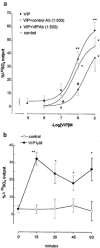
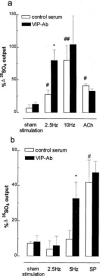
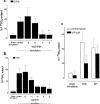

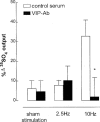

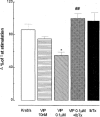

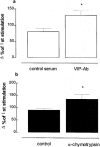
Similar articles
-
Effect of vasoactive intestinal peptide (VIP)-related peptides on cholinergic neurogenic and direct mucus secretion in ferret trachea in vitro.Br J Pharmacol. 1999 Nov;128(6):1353-9. doi: 10.1038/sj.bjp.0702942. Br J Pharmacol. 1999. PMID: 10578152 Free PMC article.
-
Neuroregulation of mucus secretion by opioid receptors and K(ATP) and BK(Ca) channels in ferret trachea in vitro.Br J Pharmacol. 1998 Apr;123(8):1631-8. doi: 10.1038/sj.bjp.0701786. Br J Pharmacol. 1998. PMID: 9605570 Free PMC article.
-
'Sensory-efferent' neural control of mucus secretion: characterization using tachykinin receptor antagonists in ferret trachea in vitro.Br J Pharmacol. 1994 Dec;113(4):1183-90. doi: 10.1111/j.1476-5381.1994.tb17122.x. Br J Pharmacol. 1994. PMID: 7889271 Free PMC article.
-
Motor control of airway goblet cells and glands.Respir Physiol. 2001 Mar;125(1-2):129-44. doi: 10.1016/s0034-5687(00)00209-7. Respir Physiol. 2001. PMID: 11240157 Review.
-
Pharmacological regulation of the neuronal control of airway mucus secretion.Curr Opin Pharmacol. 2002 Jun;2(3):249-55. doi: 10.1016/s1471-4892(02)00146-7. Curr Opin Pharmacol. 2002. PMID: 12020465 Review.
Cited by
-
Effect of vasoactive intestinal peptide (VIP)-related peptides on cholinergic neurogenic and direct mucus secretion in ferret trachea in vitro.Br J Pharmacol. 1999 Nov;128(6):1353-9. doi: 10.1038/sj.bjp.0702942. Br J Pharmacol. 1999. PMID: 10578152 Free PMC article.
-
Role of parasympathetic nerves and muscarinic receptors in allergy and asthma.Chem Immunol Allergy. 2012;98:48-69. doi: 10.1159/000336498. Epub 2012 Jun 26. Chem Immunol Allergy. 2012. PMID: 22767057 Free PMC article.
-
PKA-dependent activation of the vascular smooth muscle isoform of KATP channels by vasoactive intestinal polypeptide and its effect on relaxation of the mesenteric resistance artery.Biochim Biophys Acta. 2008 Jan;1778(1):88-96. doi: 10.1016/j.bbamem.2007.08.030. Epub 2007 Sep 12. Biochim Biophys Acta. 2008. PMID: 17942071 Free PMC article.
-
Neural control of the lower airways: Role in cough and airway inflammatory disease.Handb Clin Neurol. 2022;188:373-391. doi: 10.1016/B978-0-323-91534-2.00013-8. Handb Clin Neurol. 2022. PMID: 35965034 Free PMC article. Review.
-
A Comparative Peptidomic Characterization of Cultured Skeletal Muscle Tissues Derived From db/db Mice.Front Endocrinol (Lausanne). 2019 Oct 29;10:741. doi: 10.3389/fendo.2019.00741. eCollection 2019. Front Endocrinol (Lausanne). 2019. PMID: 31736878 Free PMC article.
References
-
- AIZAWA H., INOUE H., SHIGYO M., TAKATA S., KOTO H., MATSUMOTO K., HARA N. VIP antagonists enhance excitatory cholinergic neuro-transmission in the human airway. Lung. 1994;172:159–167. - PubMed
-
- BANKS B.E.C., BROWN C., BURNSTOCK G.M., CLARET M., COCKS T.M., JENKINSON D.H. Apamin blocks certain neurotransmitter-induced increases in potassium permeability. Nature. 1979;282:415–417. - PubMed
-
- BARNES P.J. Neuroeffector mechanisms: the interface between inflammation and neuronal responses. J. Allergy Clin. Immunol. 1996;98:1187–1198. - PubMed
Publication types
MeSH terms
Substances
LinkOut - more resources
Full Text Sources

